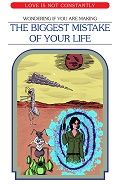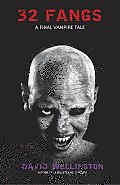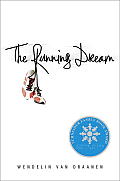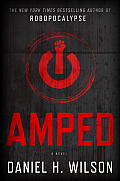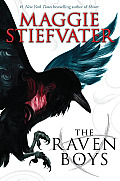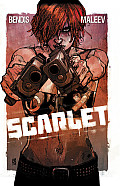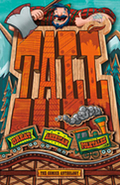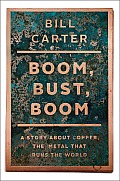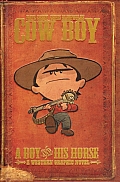Link to this review in the form of a comic strip by geneambaum tagged romance
Link to this review by geneambaum tagged thriller • paranormal • horror
WARNING: This review contains spoilers. This is the fifth vampire tale in the Laura Caxton series that started with 13 Bullets. (Go read that book first.)
The world believes that centuries-old vampire Justinia Malvern is dead. But former Pennsylvania State Trooper Laura Caxton doesn’t. She’s spent the last two years on the run from the law, giving up her relationships and any semblance of a normal life. But Caxton’s one-time partner and ex-girlfriend Clara are about to ruin the trap she’s created for Malvern.
Why I picked it up: I love Wellington’s take on vampires. If you like the end of this trailer, you will, too.
Why I finished it: Caxton’s transformation into a ruthless hunter over the course of the series is awesome. Seeing her here, at the end of her journey, through the eyes of Clara, is a marvelous way of showing that she’s become a much more focused vampire killer than her former mentor, Arkley, ever was. The chapters that show events from other books (and this one) from Malvern’s point of view are an effective, entertaining way to revisit events from earlier books while building suspense for the showdown.
I’d give it to: Bob, who prefers the original The Omega Man to the Will Smith remake, but agrees that the newer film got the vampires right.
Link to this review by silver tagged coming of age
Jessica loves running, the way the wind feels on her face when she’s running, and going out on runs with her dog, Sherlock, before anyone in her family wakes up.
Jessica woke up in a hospital bed one morning. Along with other track-team members, she had been on a bus when it overturned. Another student died. Jessica lost her right leg. She felt like her life was over — she wished she had died, because life had no point if she couldn’t run.
Why I picked it up: Gene, my personal librarian, thought this was a book I would enjoy. He knows I like stories about running and about people overcoming life’s obstacles.
Why I finished it: It is a fast-paced, short book. I’m a physical therapist, and the professional part of me wanted to see how a super-motivated, young person like Jessica could recover and return to her previous level of function. And after she returned to class, she had to sit at the back of the room, with a girl who had CP. Their friendship, and Jessica’s realization of her new friend’s abilities (and her own new strengths) pulled me along, too.
I’d give it to: Damon, a young friend of mine relearning how to walk. More often than not, he thinks he won’t be able to, and doubts he’ll have a life.
Link to this review by billba tagged science fiction
The world has been transformed by the amp, a tiny device implanted in the skull that regulates and enhances brain activity. The injured become whole, and the healthy become smarter, faster, and stronger. Increasingly, those without amps cannot compete in school or the workplace. Things come to a head when the Supreme Court rules that the amped, having elected to make themselves more than human, are not entitled to basic civil rights.
Owen Grey doesn’t consider himself particularly advantaged by his amp. His father, one of the early developers of the technology, implanted it to keep Owen’s epilepsy under control. But it doesn’t matter — soon he is out of a job, out of an apartment, and then just trying to stay alive.
As the social rift becomes violent, Owen discovers that his amp has some undocumented features.
Why I picked it up: Nancy Pearl gushed about Wilson’s Robopocalypse.
Why I finished it: This novel races along so fast I hardly felt I had the choice to stop. Owen joins the amp subculture, meets its superpowered leaders, and discovers a dark conspiracy. But the nerdy truth is that I was most intrigued by the issues of constitutional law Wilson raises.
I’d give it to: My son Theo, who will see the parallels between the amped and the super soldier threads that run through Marvel’s comic book universe(s).
Link to this review by flemtastic tagged paranormal • coming of age
Blue is different from the other girls at school — she’s part of a family of real psychics. One night, while using her ability to augment the powers of others, she sees a vision of a student at a ritzy private high school, Gansey. (He’s walking The Corpse Road as a spirit, indicating that he will die in the next year.) He and the other Raven Boys (so named for the raven on their school uniform) are looking for ley lines. Blue’s mother tells her to stay away from Gansey, but she’s soon helping him and his friends, putting them all in mortal danger and subjecting them to the time-altering effects of the lines.
Why I picked it up: After reading Stiefvater’s beautiful and creative The Scorpio Races, I will read anything Stiefvater writes.
Why I finished it: Spoiled, private-school boys seeking power are nothing new, but Stiefvater brings a logic and verisimilitude to what might otherwise be a far-fetched plot. Gansey’s lifelong interest in fantasy lore and occult literature, as well as Blue’s family, their bickering, and their useful (but limited) psychic powers make the story sharp and convincing.
I’d give it to: Crystal, because Gansey’s roommate raises a found raven chick, waking every two hours to feed it. Not only would she like Ronan’s care for animals, she would like that he names the bird Chainsaw.
Link to this review by dawnrutherford tagged graphic novel • thriller
Scarlet and her friends are sitting out in the square in downtown Portland, enjoying the sun and conversation. A couple of police officers demand they get up against the wall, empty their pockets, and give them their drug stash (they don’t have any drugs). When Scarlet’s boyfriend protests, things escalate. He punches one of the cops then takes her hand and runs. They are followed to Powell’s bookstore, where they are cornered and shot. He dies instantly. She wakes up in a hospital. The headline: “Teen Druglord Gunned Down”.
Scarlet struggles to understand why this happened, and how the man who killed her boyfriend in cold blood is now a hero. The answers she finds bring her no peace and send her down a dark, violent road.
Why I picked it up: The confrontational way Scarlet stares out from the cover, with her guns pointed at your chest, had a strength and conviction to it that made me want to know her story.
Why I finished it: While on one level this could be seen as the story of a serial cop-killer, Bendis does an amazing job of making the reader wonder just how much corruption and personal loss one could tolerate before seeking vengeance. Scarlet gradually reveals her life in heartbreaking detail, and is chillingly unapologetic.
I’d give it to: Gordon, who would appreciate Scarlet’s desperate journey from oblivious citizen to folk hero as she becomes the inspiration for a protest movement.
Link to this review by geneambaum tagged anthology • graphic novel
An anthology of American folktales told in comics format. Paul Bunyan’s footprints become Minnesota’s ten thousand lakes, Pecos Bill lassos a twister, John Henry out-tunnels a mechanical drill, and Johnny Appleseed does a lot of planting.
These books were originally published by Stone Arch as separate graphic novels: The Tall Tales of Paul Bunyan, Pecos Bill: Colossal Cowboy, John Henry: Hammerin’ Hero, and The Legend of Johnny Appleseed.
Why I picked it up: I saw the series on the shelf at Michele Gorman’s place, and she said it was excellent.
Why I finished it: The art is different for each tale, but all use the comics format in pleasant ways. My favorite was the Paul Bunyan story with its bright colors, extremely cartoony drawings, and details I don’t remember from reading the stories previously: the Seven Ax-men named Elmer and Sport the Reversible Dog.
I’d give it to: Iggy, in the hopes that he’d ask me 1) how Pecos Bill managed to keep his underwear on during the years he was raised by coyotes and 2) since he managed to keep it on, how did he go to the bathroom.
Link to this review by flemtastic tagged nonfiction
Bill Carter started a vegetable garden in his backyard in Bisbee, AZ, to have fresh, healthy food on hand. After he was sickened by home-grown veggies that had high levels of arsenic because of contamination from the town’s copper mine’s smelter, he began an in-depth look at copper: its uses, mining, and multinational corporations that engage in human rights abuses and possibly genocide to keep it flowing. Carter examines mines the world over, with details about production levels and techniques, environmental damage, and interviews with the men who run the machines (some have tires thirteen feet tall!).
Why I picked it up: The cover blurb compared Carter’s writing style to that of Jon Krakauer, an author whose work I have always enjoyed.
Why I finished it: Carter is not anti-mine, but he makes a compelling case for fighting a proposed mine in Alaska, the Pebble Mine, which would be only fourteen miles from the largest salmon run in the world. Pebble would add 300,000 tons of crushed rock, slag, and chemicals to a giant holding pit every day, 365 days a year, and Carter is worried that blooms of chemicals would make their way into the water table.
Also, I loved the unexpected details. All household doorknobs and metal surfaces may soon be copper as it is still plentiful, and will be for literally millions of years at our current rate of usage. Copper kills germs, so it’s also useful for preventing E. coli and MRSA outbreaks.
I’d give it to: James, who would be scandalized by the aggressive, borderline illegal tactics by which the big money corporations slowly buy out key landowners in small towns where they hope to establish mining operations. He would especially like the depth of information about towns where the mining company owns everything and employs everybody in town — a situation that smacks of sharecropping and serfdom.
Link to this review by snow tagged western • graphic novel • humor
Boyd is a little short for a bounty hunter. This ten-year-old knows, though, that bounty hunting is simple. “A man done wrong. You get that man. Give him to the law. Get paid for your effort.”
He finds that things get less simple when the bounty you’re collecting is on a member of your no-good, low-life family.
Publisher’s Rating: “E - Everyone. This book contains content suitable for readers of all ages. It may contain minimal violence.”
Why I picked it up: I couldn’t resist the cover image of the small, scruffy boy holding a shotgun with a stock that looks like a child’s toy.
Why I finished it: The combination of snappy dialogue (“Mighty big gun for a little boy.” “Wouldn’t worry too much ‘bout my gun, sir. But I might fret about its bullets.”) and adorable art made me alternately smile and sniffle. I hope there are plans for a sequel!
I also loved the short comics in-between the chapters, created by Roger Langridge, Brian Clevinger, Scott Wegener, Mitch Gerads, Colleen Coover, and Mike Maihack. These ranged from off-beat to romantic to just plain silly, and added to the half-serious/half-silly world that Cosby and Eliopoulos created.
I’d give it to: Kevin. At thirteen, he thinks he’s way too grown-up for books written for kids or teens, but he’s a big enough Calvin and Hobbes fan that he’ll be interested in Eliopoulos’s depiction of young Boyd. Plus the violence and some of the jokes are a little more mature than the publisher’s rating might lead him to expect.
